C. Plath
Navistar Classic Sextant

Presented is a fine example of a post-war C. Plath sextant, Serial No. 63023. It has a nicely finished and cushioned Mahogany case with a wide-angle 4 x 40 coated optics telescope. The original certificate, dated 12/8/83, issued by C Plath, is included.
This is an excellent choice for someone looking for a top-of-the-line sextant, considered one of the finest on the market.
Price: $1900.00 Shipping: $55.00
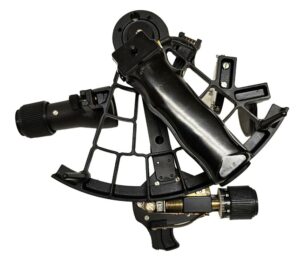 Back View
Back View
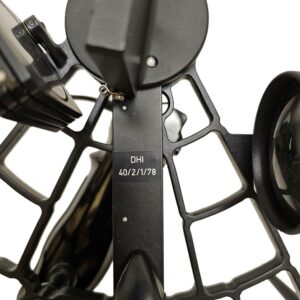
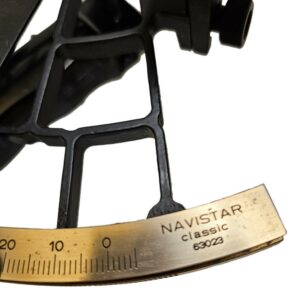 |
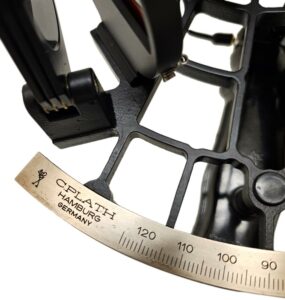 |
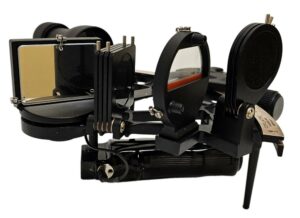 |
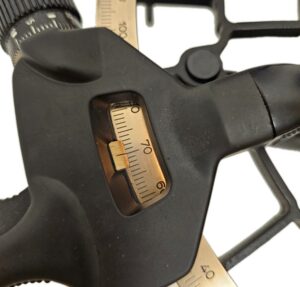 |
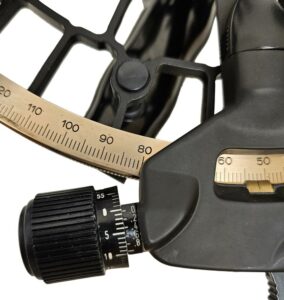
2. The Navistar brand imprint on the arc.
3. The vernier has six indents and reads to 10 seconds of arc.
4. Comes with a fine wood case with an absorbent liner,
5. And originally comes with an instruction booklet, and Plath’s
certification with matching numbers, which are present.
Measuring
Range: -5 to 125 degrees
Telescope: 4 x 40 Coated optics
Frame: Bronze
with black enamel paint and bronze arc.
Micrometer Drum and Vernier Scale: reads to 10 seconds of
arc
Index Mirror: 59 x 44 mm. Aluminized on the rear side.
Horizon Mirror:
57mm diameter.
Shades:
4 for index mirror
3 for horizon
mirrorWeight sextant: 4.2 lbs with
4 x 40 scope.
Weight: 6 lbs.
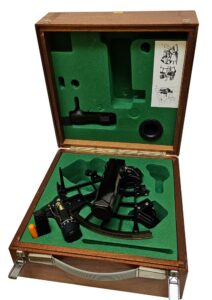
 |
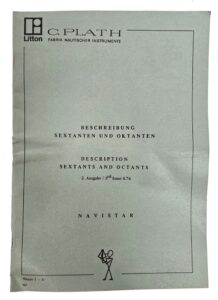 |
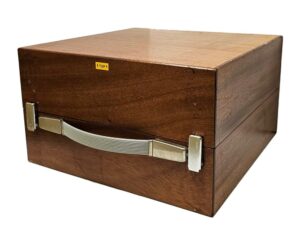
The case is in reasonably good condition, showing some age. Unfortunately, someone put masking tape on the case, possibly to hold it together as the latches are not as solid as the original. We’ve managed to remove the tape and the residue. There are a few minor scratches.
History of the C Plath Company
In brief, Carl Plath started manufacturing sextants and other nautical products in Hamburg, Germany, in 1862 through the purchase of the David Filby instrument company. However, the company’s origin dates back to 1837. As a result of WW II, C.Plath was entirely dismantled by the occupation forces. Around 1950, various prohibitions were lifted, and C. Plath was allowed to begin production again of sextants and other nautical instruments. Also, in 1949, C.Plath was offered a gyrocompass patent; in 1951, the first gyrocompass designed for this patent was presented to the public. C.Plath progressed from the role of instrument maker to that of a modern marine navigation equipment manufacturer. The product range was expanded in the following years by many more contemporary designs, such as autopilots, speed logs, radio direction finders, etc.
In 1962, C.Plath was acquired by Litton Industries, a significant American concern. The C.Plath North American Division was set up in 1978 in College Park near Washington. 1996 saw the introduction of the world’s first fiber-optic solid-state gyrocompass by C.Plath. The first-ever gyrocompass with no moving parts. Sperry Marine was formed in 1997 with the combination of C.Plath, Decca Marine, and Sperry Marine, with more organizational changes yet to come. After 163 years, C.Plath changed its name to Sperry Marine in May 2000. In 2001, Sperry Marine became part of the Northrop Grumman Corporation. In the 1990s, Plath came out with a series of new sextant designs with overlapping designs and confusing names. They seemed to have lost their way. Shortly thereafter, C. Plath quit producing sextants.
This Navistar Classic is equal to the Navistar Royal in Plath’s line of premium sextants and was made in limited quantities to the same degree of non-adjustable instrument error of 8 arc seconds, putting it in the same class. Because it was a new design in 1990 with many advanced features, it sold for more than other sextants. The visual clues are the flat index arm with diode lighting, the special micrometer drum with a rotating vernier, and the Navistar brand imprint. The rotating vernier has six indents and reads to 10 seconds of arc. You turn it to match the “0” point with the “0” on the micrometer drum so that the index error reads zero. It has its original detailed instruction booklet, with Plath certification and the number 61925, but no date. C. Plath quit producing sextants around 2001. The parent company has completely liquidated everything, including machinery, equipment, and spare parts.
